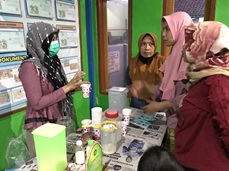Pemberdayaan Masyarakat Desa Gadingkulon Dau Kabupaten Malang melalui Pelatihan Pembuatan Kefir untuk Meningkatkan Nilai Ekonomis Susu Sapi Community Empowerment in Gadingkulon Dau Village, Malang Regency through Kefir Making Training to Increase the Economic Value of Cow's Milk
Main Article Content
Abstract
Gadingkulon Village, Dau District, Malang Regency, is one of the villages producing cow's milk, which is quite productive. To increase the economic value of cow's milk, one way of processing it is to make it into kefir. Kefir is a fermented drink made from cow's milk using kefir seeds, which has the benefit of being a probiotic that is needed to maintain body immunity, especially during a pandemic. Training on making cow's milk kefir for a group of cow's milk farmers in Gadingkulon village can provide another alternative for processing cow's milk to produce a halal probiotic product to increase people's immunity during a pandemic while at the same time increasing the selling value of cow's milk which has the potential to increase the income of cow's milk farmers. This empowerment activity was carried out using the observation and training method with the target of PKK women in Gadingkulon Village. The information results stated that the activity participants needed to become more familiar with the terms and benefits of kefir as a probiotic drink, which helps increase body immunity. The results of the community empowerment showed that the participants could understand and practice how to make cow's milk kefir, pack it aseptically, and form a kefir community in the Gadingkulon village.
Downloads
Article Details

This work is licensed under a Creative Commons Attribution-ShareAlike 4.0 International License.
Authors who publish with this journal agree to the following terms:
- Any article on the copyright is retained by the author(s).
- Author grant the journal, right of first publication with the work simultaneously licensed under a Creative Commons Attribution License that allows others to share work with acknowledgment of the work authors and initial publications in this journal.
- Authors are able to enter into a separate, additional contractual arrangements for non-exclusive distribution of published articles of work (eg, post-institutional repository) or publish it in a book, with acknowledgment of its initial publication in this journal.
- Authors are permitted and encouraged to post their work online (e.g., in institutional repositories or on their websites) prior to and during the submission process, as can lead to productive exchanges, as well as earlier and greater citation of published work.
- The article and any associated published material is distributed under the Creative Commons Attribution-ShareAlike 4.0 International License
References
Alves, E., Ntungwe, E. N., Gregório, J., Rodrigues, L. M., Pereira-Leite, C., Caleja, C., et al. (2021). Characterization of Kefir Produced in Household Conditions: Physicochemical and Nutritional Profile, and Storage Stability. Foods, 10(5), 1057. https://doi.org/10.3390/foods10051057
Aqmarina, A., Adnan, N., & Hastuti, E. B. (2022). COVID-19 Deaths with Age Standardization by Region in Indonesia from March 2020 to May 2021. Jurnal Epidemiologi Kesehatan Indonesia, 6(2), 1–10. http://dx.doi.org/10.7454/epidkes.v6i2.6312
Azizi, N. F., Kumar, M. R., Yeap, S. K., Abdullah, J. O., Khalid, M., Omar, A. R., et al. (2021). Kefir and its biological activities. Foods, 10(6), 1210. https://doi.org/10.3390/foods10061210
Bourrie, B. C. T., Willing, B. P., & Cotter, P. D. (2016). The microbiota and health promoting characteristics of the fermented beverage kefir. Frontiers in Microbiology, 7, 647. https://doi.org/10.3389/fmicb.2016.00647
Çon, A. H. & Dertli, E. (2017). Microbial diversity of traditional kefir grains and their role on kefir aroma. LWT - Food Science and Technology, 85(11), 151–157. https://doi.org/10.1016/J.LWT.2017.07.017
Gul, O., Mortas, M., Atalar, I., Dervisoglu, M., & Kahyaoglu, T. (2015). Manufacture and characterization of kefir made from cow and buffalo milk, using kefir grain and starter culture. Journal of Dairy Science, 98(3), 1517–1525. https://doi.org/10.3168/jds.2014-8755
Guzel-Seydim, Z. B., Kok-Tas, T., Greene, A. K., & Seydim, A. C. (2011). Review: functional properties of kefir. Critical Reviews in Food Science and Nutrition, 51(3), 261-268. https://doi.org/10.1080/10408390903579029
Machado, A., Leite, D. O., Antonio, M., Miguel, L., Peixoto, R. S., Rosado, A. S., et al. (2013). Microbiological, technological and therapeutic properties of kefir: a natural probiotic beverage. Brazilian Journal of Microbiology, 349(2), 341–349. https://doi.org/10.1590/S1517-83822013000200001
Prado, M. R., Blandón, L. M., Vandenberghe, L. P. S., Rodrigues, C., Castro, G. R., Thomaz-Soccol, V., et al. (2015). Milk kefir: Composition, microbial cultures, biological activities, and related products. Frontiers in Microbiology, 6, 1177. https://doi.org/10.3389/fmicb.2015.01177
Rosa, D. D., Dias, M. M. S., Grzes´kowiakgrzes´kowiak, Ł. M., Reis, S. A., Conceição, L. L., Do, M., et al. (2017). Milk kefir: Nutritional, Microbiological and Health Benefits. Nutrition Research Reviews, 30(2), 82-96. https://doi.org/10.1017/S0954422416000275
